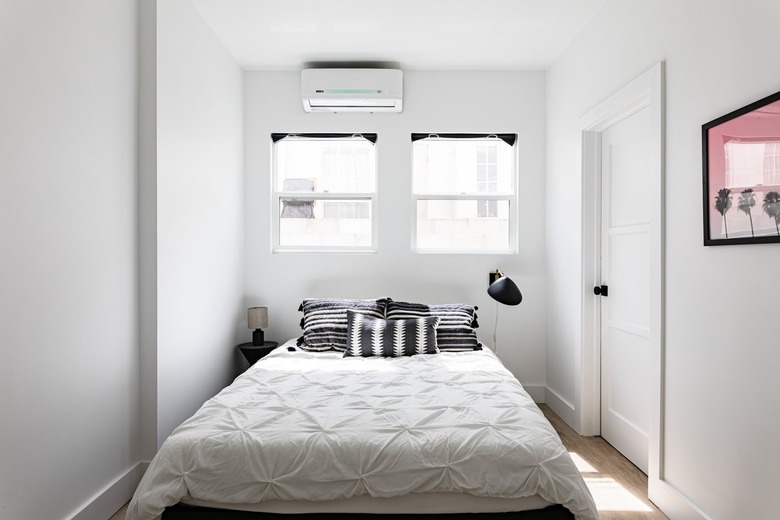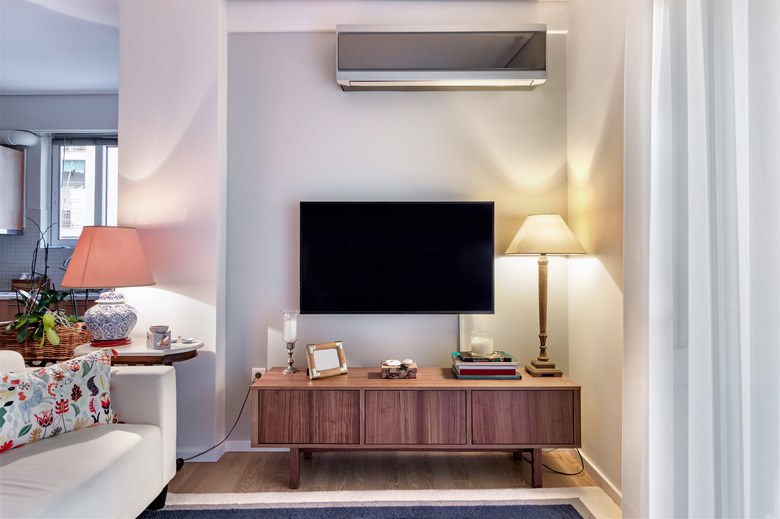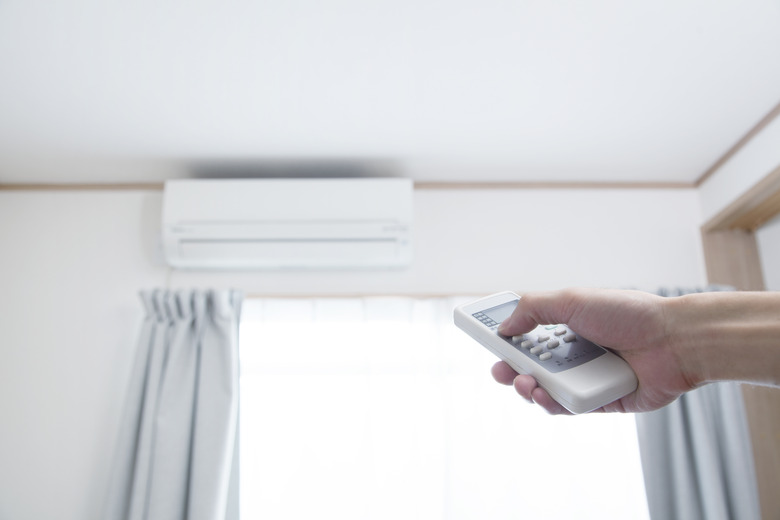What Size Minisplit System Do I Need? A Guide To Sizing Btu
We may receive a commission on purchases made from links.
Minisplit heating/cooling systems, also known as ductless heat pumps, are an increasingly popular way to add air conditioning in places where a traditional central air-conditioning system is not practical. For example, a minisplit system can easily be installed in a home that is heated by a boiler and radiators and where there is no existing ductwork that can be utilized by a central air-conditioning system.
Understanding how minisplit systems are properly sized will help you make sure the contractor is installing the proper equipment. While it is possible for DIYers to purchase all the components for a minisplit system, manufacturers often refuse to warranty the systems that are not installed by licensed professionals. It's therefore rare for homeowners to install minisplit systems themselves.
Minisplit System Basics
Minisplit System Basics
Ductless minisplit systems are a form of air-source heat pump that works by absorbing heat from one space and releasing it to another through the natural physics that occurs when a refrigerant gas is alternately compressed and expanded. These systems feature a single outdoor condenser/compressor unit along with one or more interior air handlers. Rather than using a ductwork system with a central blower, minisplit systems are ductless, with each indoor air unit containing its own quiet blower. The blower blows air over condenser coils filled with chilled refrigerant to cool the room. The refrigerant circulates through tubing running between the outdoor condenser unit and the indoor air handlers.
Minisplit systems operate in much the same way as traditional room air conditioners but with an important difference. Like any air conditioner, these systems work by means of coils and tubes filled with refrigerant. The constantly flowing refrigerant expands into a cool gas as it passes through the evaporator coils in the indoor air handlers, where they absorb room heat. The refrigerant then flows through a 2- to 3-inch tube through the wall to the outdoor condenser, where it is compressed into a hot liquid that surrenders its heat to the outdoors.
Unlike standard air conditioners, minisplit systems have a reversing valve that allows the system to work as a heater as well, absorbing heat from outdoor air and releasing it to the indoors. Which function it serves depends on the direction of the refrigerant flow and on where the refrigerant is absorbing and surrendering its heat.
Traditionally, this type of heat pump was installed primarily as a cooling system and could heat effectively only with outdoor temperatures down to around 20 degrees Fahrenheit, but some modern minisplits are now designed to serve as heaters in climates down to about minus 15 degrees. Make sure to discuss this with your installer if you want to use your minisplit as a primary heating system at these low temperatures. It may be possible for a minisplit system to serve as the primary heating system for a home as well as its air-conditioning system.
Single-Zone vs. Multizone Systems
Single-Zone vs. Multizone Systems
Minisplit systems can be single-zone or multizone. A single-zone system has an outdoor condenser/compressor unit combined with a single indoor air handler managed by a single thermostat and control. A multizone system also has a single outdoor unit, but it supplies two or more indoor air handlers, each with its own thermostat that operates a separate zone. Today's largest minisplit systems can power as many as nine different indoor zones from a single outdoor unit, but most residential minisplit heat pumps can handle no more than about 1,500 square feet of indoor space. Homes larger than this generally have two or more outdoor minisplit condenser/compressor units to feed several indoor air handlers serving different zones.
Sizing a Minisplit System
Sizing a Minisplit System
Like any HVAC system, sizing a minisplit system is done based on the Btu (British thermal unit) needs of the indoor space. This is (or should be) a fairly complicated calculation based on the size of the indoor space plus a host of other variables.
Sizing a minisplit system begins with a very basic calculation of Btu needs for the home based on square footage. It's important to note, however, that this is merely a place to start. An installation professional who uses only the square footage figure to suggest a size for your minisplit system is taking the easy route. There should be a number of adjustments the contractor considers.
Although each manufacturer will have a slightly different method for sizing a system, this sizing guide can be used as the starting point for Btu calculation:
|
Total Area Served |
Minisplit Btu Rating |
|
150 to 300 sq. ft. |
6,000 |
|
300 to 500 sq. ft. |
9,000 |
|
400 to 650 sq. ft. |
12,000 |
|
500 to 800 sq. ft. |
15,000 |
|
600 to 1,000 sq. ft. |
18,000 |
|
800 to 1,300 sq. ft. |
24,000 |
|
1,000 to 1,650 sq. ft. |
30,000 |
|
1,200 to 2,000 sq. ft. |
36,000 |
|
1,400 to 2,300 sq. ft. |
42,000 |
|
1,600 to 2,650 sq. ft. |
48,000 |
|
1,850 to 3,100 sq. ft. |
56,000 |
However, there are many different online calculators available that purport to help DIYers calculate the proper Btu load for a minisplit system, and it's important to use a method approved by the specific manufacturer. For some manufacturers, the basic load calculation method begins by finding the square footage of the area served (length x width) and then multiplying by 25. With this method, for example, an open-plan room with 600 square feet has a base Btu need of 15,000 (600 x 25) Btu.
Sizing Adjustments
Sizing Adjustments
Whatever basic calculation method is used, this base Btu rating is just a starting point. If you have a modern, well-insulated house in a mild climate zone, it's possible that this figure alone will provide the proper size for a minisplit system, but it's more likely that your contractor will need to apply several adjustments to arrive at the proper Btu load rating for your minisplit system:
- Climate: If you live in an area where the temperatures regularly exceed 90 degrees Fahrenheit, it's common to increase the Btu rating of the system by at least 30 percent.
- Age of home/insulation value: Because older homes typically have inferior insulation and air sealing, it will almost certainly take more power to cool or heat these homes. Therefore, it is standard to increase the basic Btu rating by 30 percent on older homes.
- Ceiling height: Basic BTU ratings assume a ceiling height of 8 feet. If your home has 9- or 10-foot ceilings, then it's common to increase the Btu rating by 20 percent.
These three factors alone, if all are present, may cause the contractor to raise the Btu sizing of your system by as much as 80 percent above the base Btu calculation. Other factors that the contractor will factor in, though in a less dramatic way, include:
- Windows and doors: Homes with many windows and doors will need a higher basic Btu rating for minisplit sizing purposes.
- Direct sunlight: A home that experiences lots of direct sunlight may call for a higher Btu rating for cooling purposes (but a lower Btu rating for heating purposes).
- Kitchen: A minisplit system that serves a kitchen may require a larger Btu rating for calculating cooling needs to offset the heat generated by appliances.
- Number of residents: Human bodies generate heat, and a good contractor will factor this in when computing the appropriate Btu load of a minisplit system.
- Type of floor: A home that is fully carpeted gains some insulation value from the carpet and padding. Thus, the required Btu capacity for a minisplit system can sometimes be slightly reduced.
- Electronic equipment in the room: Computers, printers, televisions and other electronics all give off heat, and this may require upward adjustment to the Btu rating when calculating the load for an air-conditioning system.
- Heat-emitting light bulbs: Even the number of incandescent light bulbs in a room can change the Btu rating of a particular room. A good contractor will keep all such factors in mind.
If your minisplit contractor takes careful measurements of your spaces and asks about all these variables (and perhaps even more), it's a good sign that he is correctly sizing your minisplit system. Some manufacturers offer their installers complicated software that factors in values for dozens of different variables to compute the BTU needs for spaces served by a minisplit system. It is entirely possible — for example, if you have an older house with 10-foot ceilings and many large windows — that the contractor may correctly suggest a minisplit size that is as much as twice the basic Btu rating that was calculated based on the area of the space.
Individual minisplit systems can have Btu ratings as low as 6,000 Btu or as high as 56,000 Btu. In many cases, a single outdoor condenser unit will serve one or more indoor air handlers. However, for large homes, it is common to install two smaller units rather than a single large compressor/condenser unit. Most minisplit units installed will fall between 9,000 and 36,000 Btu in size.
Importance of Proper Sizing
Importance of Proper Sizing
Proper sizing of a minisplit system is even more important than you may realize. If the system is too small (with a lower than ideal Btu rating), it may run continuously in an effort to reach the desired thermostat setting. Such systems will not just be inadequate for heating and cooling but they will lack energy efficiency by running constantly. With an undersized system, zones may have hot or cold spots since the desired temperature doesn't reach all areas of the zone, and because the system is running constantly, it is likely to develop problems and wear out quicker. If properly maintained, a minisplit system will often last 10 to 15 years, but an undersized system that runs constantly may need replacement in half that time.
Oversizing a minisplit system can also cause problems. A minisplit system that is too large tends to short-cycle, or turn on and off at short intervals. This can cause excessive wear on the system's components. Also, a too-large system is less efficient for removing humidity from the air. Your home may cool down sufficiently but still feel damp.
Btu vs. Tonnage
Btu vs. Tonnage
Most modern minisplit heat pump systems are sold according to Btu ratings, but you may also find air-conditioning equipment categorized by tonnage. This somewhat old-fashioned rating system derives from a measurement of how much energy is required to melt 1 ton of ice within 24 hours. The methodology for determining tonnage for specific systems is not important to know but be aware that 1 ton of cooling capacity extracts 12,000 Btu of heat per hour from a living space. A minisplit system described as a 2-ton system, for example, translates as a 24,000 Btu system.
The Bottom Line
The Bottom Line
Properly sizing a minisplit heat pump system begins with determining the square footage area of the space that will be cooled and/or heated, but the end calculation should also involve adjustments for additional variables, including climate, age and insulation value of your home, number of windows and doors, ceiling height and other factors. To ensure that your system operates efficiently, make sure your minisplit system is sized according to the method recommended by the equipment manufacturer.


